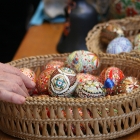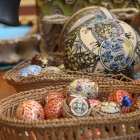Painted Easter eggs, a folkloric tradition in Romania
In some Orthodox countries there is a tradition of skilfully painting eggs before Easter. The tradition is very vivid in areas of Romania like Bukovina (the Nordic part of Moldova). A legend has it that when Jesus Christ was crucified, Mary Magdalene came at the feet of the cross with a basket of food she had bought. The blood of the Lord dropped over the eggs in the basket, turning them red. Following this legend, Christians in the East started painting eggs in red in the Thursday before Easter. This is still done in every Romanian family, using a simple method, by dipping the boiled eggs into a pot with food dye.
But of hundreds of years, in villages of Bukovina, this custom was turned into an art. To paint the eggs, the peasants don’t use synthetic dyes, but rather natural herbs. They can obtain red from apple leaves, madder, wild rose, green from walnut leaves, sunflower, yellow from peel onions, privet, blue from violet flowers, black from nutshell and alder. The decorations are usually geometric, various shapes of flowers and animals, but got to the point where entire icons like “The last supper” or “Madonna with Child” were painted on an hen egg. To achieve this, the peasants use the simplest tool (called kishitze), a stick with an iron tip. With this, they apply molten wax on the desired pattern of the first color. Then they dip the egg in the lightest color to be used. When heated, the protective wax melts away, and a new pattern can be added. Then another dip in a different color, and so on.
As these little works of art began to be collected, popular artists are preparing them for the buyers. The substance of the egg is taken out through a tiny hole before boiling, so the crust is more resistant in time. Because of the demand, the craftsmen started also to paint ostrich eggs or wooden eggs.
In the cities, the tradition is preserved in every house, but without the artistic painting part. The eggs are simply dipped in food dye, in various uniform colors, not only the traditional red.
The symbolic aspect of painting and knocking eggs on Easter is far more important than the folkloric aspect later developed. In Romanian, the name for Easter is derived from the Hebrew name (Passover, from Pesah) of the celebration of the departure of the Jewish people lead by Moses from the slavery in Egypt.
In Christian terms, the Easter is also a turning point, from the slavery of sin to the hope of another life. The egg thus serves very well this symbolism: its shell is like the stone that covers a grave, which when cracked opens the way into a superior form of living. When two Christians knock the painted eggs on Easter, the first one says: “Christ has resurrected!”. To this, the other responds: “Indeed He did!”.
Romanians also use these two ritualistic formulas to greet on the street in the first week after Easter, as this is considered the defining affirmation of the Christian faith.
Mai multe despre: Romania • Bucovina • Easter • obiceiuri de Paste • oua incondeiate • oua rosii • painted eggs • sarbatori crestine • traditii de Paste • traditions- Home Page
start page - Architecture
landmark buildings - Sacred architecture
places of worship - Nature
landscape photography - Concert
performing artists - Christmas
Santa Claus pictures
- Jooble
jobs for photographers - Escape
an out of control blog - Merry Christmas
The best organizer of Christmas parties - Astro photo
Eclipse hunting and astrological photography



